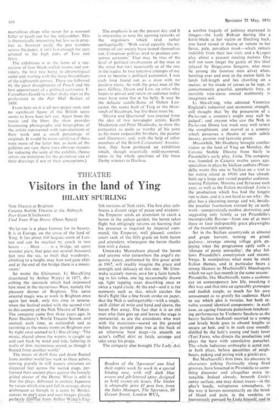CARTOONS
Yesterday's news
MICHAEL FFOLKES
Bang on the stroke of five we were urged vigorously into the street from the exhibition at the National Portrait Gallery, 'Drawn and Quartered : The World of the British Newspaper Cartoon', by three gentlemen in shiny black caps. Which was not inap- propriate, since this political and social pro- gress through the last two hundred and fifty y-ars is taken at a rapid pace, to a musical accompaniment of George Formby and Rock 'n' Roll and a series of flickering screens, set near the ceiling, showing Neville Chamberlain grinning toothily after Munich and Bertrand Russell seated glumly in Trafalgar Square waiting for arrest.
A more leisurely note is struck by Harold Macmillan who, in a taped interview, gives in sonorous tones his very reasonable opi- nion that the late Vicky was the best car- \toonist of his time; but then we are on again to the last room where the most eye-catching
feature is a split-screen Day in the Life of Giles', a fast-moving series of stills that reveal the travail of the political cartoonist thinking and drawing (and doing a spot of pretty neat welding into the bargain). Other screens show the growth of actual drawings under the nerveless hands of their creators. marvellous chaps who never for a moment falter or reach out for the indiarubber. This is theoretically interesting but less so in prac- tice as, however easily the pen wanders across the paper, it isn't fast enough for eyes attuned to the high jinks of Tom and Jerry.
The exhibition is in the form of a suc- cession of four black-walled rooms and cor- ridors, the first two being in chronological order and starting with the fierce broadsheets of the eighteenth century. These are followed by the great draughtsmen of Punch and the first appointment of a political cartoonist, F. Carruthers Gould (a rather shaky start to the profession) in the Pall Mall Budget of 1888.
From here on it is all newspaper men, and no significant figure of the British scene seems to have been left out. Apart from the music and the films, the show provides fascinating photographs and biographies of the artists represented with reproductions of their work and a small percentage of originals. It would be more satisfying if there were more of the latter but, as none of the galleries are vast, there were obvious reasons for reducing the scale of the exhibits. (Some artists are notorious for the grandiose size of their drawings if not of their conceptions.)
The emphasis is on the present day and it is interesting to note the opening remarks of the organisers which read rather apologetically : 'With social equality the ex- tremes of our society have ironed themselves out. Consensus politics tend to produce con- sensus cartoons.' That may be true of the level of political involvement of the man in the street but isn't necessarily so of the one in the studio. In two tentative attempts of my own to become a political cartoonist, I was each time found out as a man with no positive views. As with the great men of the past, Gillray, Dyson and Low, an artist who hopes to attract and retain an audience today must have some fire in his belly. It may be the delicate candle-flame of Osbert Lan- caster, the sauna bath of Trog or the blow- torch of Steadman, but fire there must be.
'Drawn and Quartered' was created from the idea of two newspaper artists, Keith Mackenzie and Peter Maddocks, to show the cartoonist as quite as worthy of his corn as his more respectable brothers, the painter and illustrator; and, with the help of other members of the British Cartoonists' Associa- tion, they have produced an exhibition which, though essentially mild-mannered, takes in the whole spectrum of life from Derby winners to Dachau.



































 Previous page
Previous page